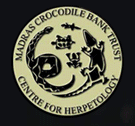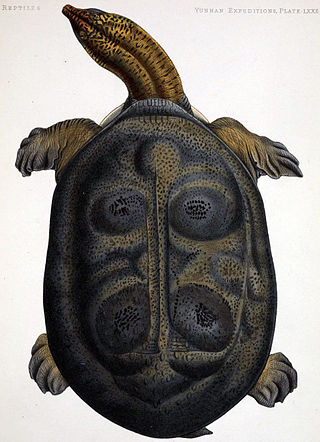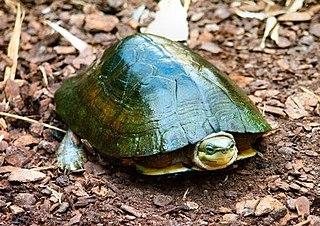
The Madras Crocodile Bank Trust and Centre for Herpetology (MCBT) is a reptile zoo and herpetology research station, located 40 kilometres (25 mi) south of the city of Chennai, in state of Tamil Nadu, India. The centre is both a registered trust and a recognized zoo under the Wildlife (Protection) Act, 1972 and comes under the purview of the Central Zoo Authority, Ministry of Environment, Forest and Climate Change, Government of India. It was established with the aim of saving three Indian endangered species of crocodile—the marsh or mugger crocodile, the saltwater crocodile, and the gharial, which at the time of founding of the trust were all nearing extinction.

The Bolson tortoise, also called the Mexican giant tortoise or yellow-margined tortoise, is a species of tortoise from North America. Of the six North American tortoise species, it is the largest, having a carapace length of about 46 cm (18 in). It lives in a region of the Chihuahuan Desert known as the Bolsón de Mapimí, which is located in north-central Mexico.

The leopard tortoise is a large and attractively marked tortoise found in the savannas of eastern and southern Africa, from Sudan to the southern Cape Province. It is the only extant member of the genus Stigmochelys, although in the past, it was commonly placed in Geochelone. This tortoise is a grazing species that favors semiarid, thorny to grassland habitats. In both very hot and very cold weather, it may dwell in abandoned fox, jackal, or aardvark burrows. The leopard tortoise does not dig other than to make nests in which to lay eggs. Given its propensity for grassland habitats, it grazes extensively upon mixed grasses. It also favors succulents and thistles.

The Malayan flat-shelled turtle is a species of turtle found in Southeast Asia.

The northern river terrapin is a species of riverine turtle native to Southeast Asia. It has been classified as Critically Endangered on the IUCN Red List and considered extinct in much of its former range; as of 2018, the population in the wild was estimated at 100 mature individuals.

The Amboina box turtle or Southeast Asian box turtle is a species of Asian box turtle widely distributed across Southeast Asia. It is native to the Asian mainland from northeast India, through Bangladesh, Burma and Thailand, across Laos, Cambodia, Vietnam, and Malaysia. It is also found on the archipelagos of Indonesia and the Philippines.

The golden coin turtle, also known commonly as the Chinese three-banded box turtle and the Chinese three-striped box turtle, is a species of turtle in the family Geoemydidae. The species is native to southern China. There are two recognized subspecies.

The radiated tortoise is a tortoise species in the family Testudinidae. Although this species is native to and most abundant in southern Madagascar, it can also be found in the rest of this island, and has been introduced to the islands of Réunion and Mauritius. It is a very long-lived species, with recorded lifespans of up to 188 years. These tortoises are classified as critically endangered by the IUCN, mainly because of the destruction of their habitat and because of poaching.

The pancake tortoise is a species of flat-shelled tortoise in the family Testudinidae. The species is native to Tanzania and Kenya. There are also small populations in northern Zambia. Its common name refers to the flat shape of its shell.

Kleinmann's tortoise, also called commonly the Egyptian tortoise, Leith's tortoise, and the Negev tortoise, is a critically endangered species of cryptodire turtle in the family Testudinidae. The species is native to Egypt, Libya, and Israel. The species was once more widespread, but its numbers are now dwindling. The species is nearly extinct in Egypt, and complete extinction in the wild is a looming threat unless more actions are taken to protect this species.

The western swamp turtle or western swamp tortoise is a critically endangered species of freshwater turtle endemic to a small portion of Western Australia. It is the only member of the genus Pseudemydura in the monotypic subfamily Pseudemydurinae.

The impressed tortoise occurs in mountainous forest areas in Southeast Asia, mainly in Myanmar Burma, southern China, Thailand, Laos, Vietnam, Cambodia, Malaysia and Northeast India. The species has a golden brown shell and skin. Adults are much smaller than their relatives the Asian forest tortoise, with a maximum carapace length of 35 cm (14 in).

The Burmese peacock softshell turtle is a species of softshell turtle in the Trionychidae family. It is one of five species in the genus Nilssonia.

The painted terrapin, painted batagur, or saw-jawed turtle is a species of turtles in the family Geoemydidae. It was formerly in its own genus, Callagur, but has been reclassified to the genus, Batagur.

Zhou's box turtle is a species of turtle in the family Geoemydidae. The species is apparently endemic to China.

The Bellinger River turtle is a species of turtle in the family Chelidae. The species is of moderate size, with a straight-line carapace length to 240 mm (9.4 in) in females, and 185 mm (7.3 in) in males. It is endemic to Australia with a highly restricted distribution to the small coastal drainage of the Bellinger River in New South Wales. In the past the species was considered locally abundant. The species' preferred habitat is the deeper pools of the clear-water upstream reaches of the river, where water flows continuously in most months over a bedrock basement and a stream bed of boulders, pebbles, and gravel. A captive breeding program has been under way since a 2015 virus outbreak came close to wiping out the entire species. Most remaining individuals are currently housed in quarantine, though a small number have been reintroduced to the original habitat.

The Burmese roofed turtle is one of six turtle species in the genus Batagur of the family Geoemydidae. It is a freshwater turtle that is endemic to the rivers of Myanmar. It was once a common and abundant turtle in its respective habitat. As populations began facing rapid decline, eventually the species was thought to be extinct, until two subpopulations were rediscovered in 2001 in the Chindwin and Dokhtawady rivers. Less than 10 mature individuals were known by 2018. The Burmese roofed turtle is one of the most critically endangered turtle species in the world.

Siebenrockiella crassicollis is a freshwater turtle endemic to Southeast Asia. It is one of two species classified under the genus Siebenrockiella in the family Geoemydidae.

The angonoka tortoise is a critically endangered species of tortoise severely threatened by poaching for the illegal pet trade. It is endemic to Madagascar. It is also known as the angonoka, ploughshare tortoise, Madagascar tortoise, or Madagascar angulated tortoise. There may be fewer than 400 of these tortoises left in the wild. It is found only in the dry forests of the Baly Bay area of northwestern Madagascar, near the town of Soalala. A captive-breeding facility was established in 1986 by the Jersey Wildlife Preservation Trust in collaboration with the Water and Forests Department. In 1996, 75 tortoises were stolen, which later appeared for sale in the Netherlands. The project was ultimately successful, achieving 224 captive-bred juveniles out of 17 adults in 2004. Project Angonoka developed conservation plans that involved local communities making firebreaks, along with the creation of a park to protect the tortoise and the forests. Monitoring of the angonoka tortoise in the global pet trade has also continued to be advocated.
Kalyar Platt is a Burmese herpetologist and turtle conservationist. She is the director of the Myanmar Program of the Turtle Survival Alliance and oversees conservation, breeding and reintroduction projects for some of Southeast Asia's rarest turtle species. She formerly worked for Wildlife Conservation Society and earned her PhD from Bangkok's Chulalongkorn University in 2007.




















